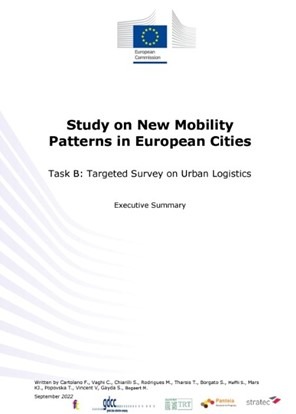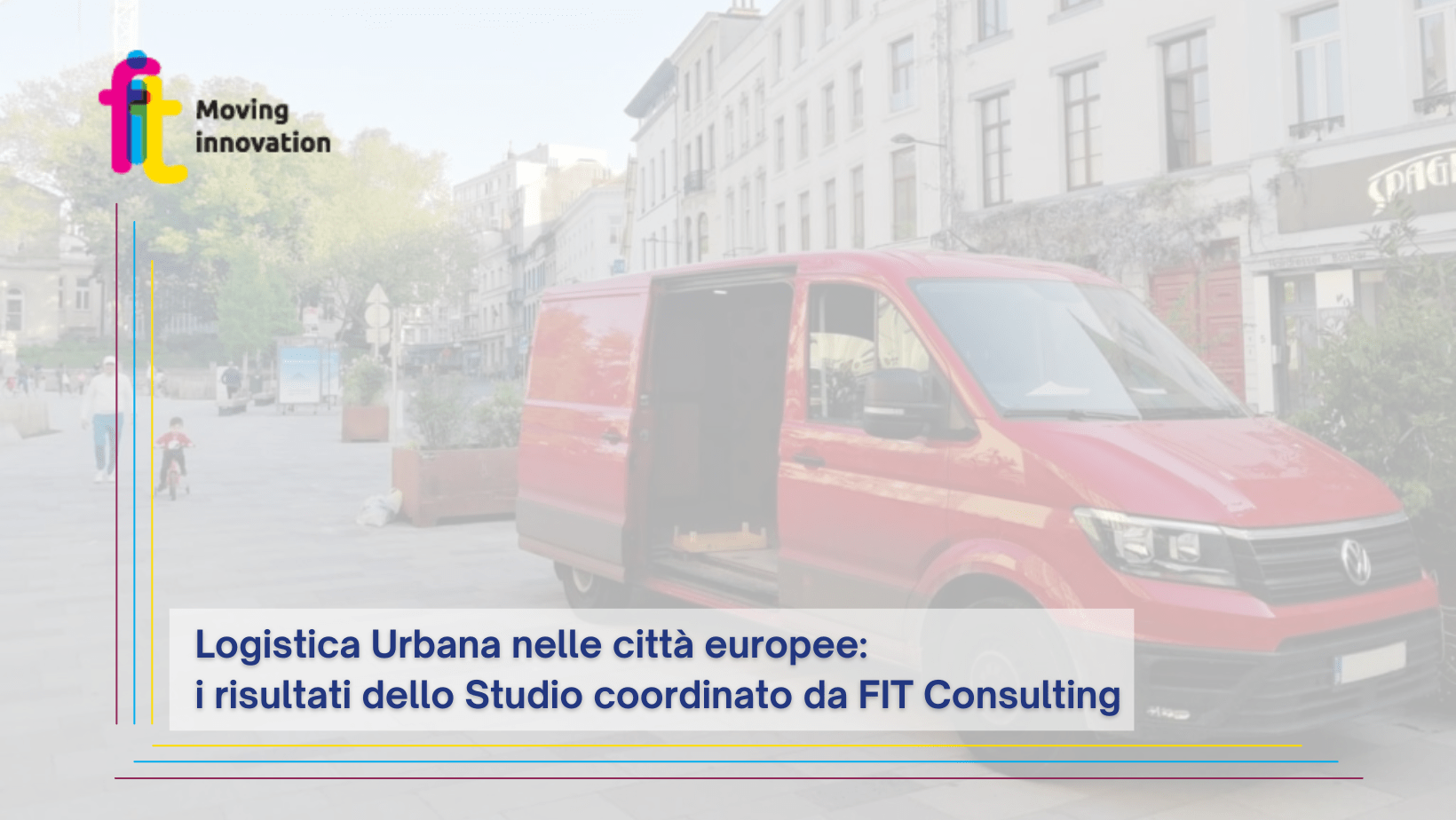The European Commission has published the results of an extensive survey on the development of the urban logistics sector in European cities. The study, co-ordinated by FIT Consulting, which supervised the methodological approach, carried out an in-depth analysis of the results and drafted the publicationfocused on urban logistics, one of the most complex and least efficient segments of freight transport, responsible for a significant share of traffic congestion and pollutant emissions in EU cities.

The Firm’s Objectives
Despite the growing interest in urban logistics in the public debate, also as a result of significant impacts generated by the rise of e-commerce, knowledge of the phenomenon in European cities remains extremely fragmented and the related data are not harmonised due to the lack of a systematic methodological approach. Furthermore, logistics operators are reluctant to share information in a highly competitive environment and in such a lucrative market.
With this in mind, the European Commission launched an investigation (called Study on New Mobility Patterns in European Cities – Targeted Survey on Urban Logistics) focused on urban logistics with the aim of collect data and make indicators available on economic, environmental and operational aspects and to lay the foundations for a better understanding of this sector and its actors, while at the same time promoting standardised methodologies for further investigation to be conducted at city level.
Systematic analysis of previous studies and surveys on urban logistics
In the first phase of the study, a systematic analysis of previous studies conducted in the sample cities was carried out, with the aim of having a methodological evaluation of the survey approach and quantitative references on the surveyed indicators to use as a basis for comparison, in order to validate the survey results.
Investigations into urban logistics are usually conducted to lay the foundations for the development of sound transport policies in a specific area or throughout the city; Sustainable Urban Logistics Plans (PULS)often part of the Sustainable Urban Mobility Plans (SUMPs)are administrative tools used by local authorities to assess and monitor logistics performance together with its implications, to identify problem areas in the city and to identify suitable solutions for improving key transport and environmental indicators.
This analysis revealed a substantial lack of systematically collected and comparable data and identified the main causes:
– freight transport in many local and model surveys is often neglected;
– Where data on freight transport is collected, in most cases it is not related to urban areas;
– the methodologies used to collect the data are not systematic; therefore, the different data cannot be compared;
– sometimes the data available (possibly through technological systems in cities) are not analysed due to the fact that this is an expensive and complex process.
The broad overview of studies conducted in the selected cities revealed differences in methodologies and confirms the hypothesis that urban logistics surveys and studies are methodologically heterogeneous and not easily comparable. The main limitations encountered when comparing data collection and analysis with the present study are as follows:
– the definitions of indicators between studies are not always consistent (e.g. there is ambiguity between the definitions of deliveries and trips);
– Some studies use enterprise classification systems other than the NACE code, so that the meanings of urban logistics are sometimes not aligned and include activities other than freight transport;
– Some studies calculate reference populations for indicators using inference methods, reporting extrapolated values without reporting their relative accuracy;
– The definitions of urban areas used are sometimes generic, mentioning ‘city centre’, ‘urban area’ or other without any exact correspondence with the official definitions adopted by the European Union.
Despite these limitations, for some cities it was possible to use the data collected to validate the results of the study.
The methodology of the survey
The questionnaire underlying the survey was carried out in CATI and CAWI mode and was translated into all languages of the cities under study.
The target population was identified among logistics operators who deliver goods by light truck.
(under 3.5 tonnes) and heavy (over 3.5 tonnes), operating in 26 metropolitan areas with a resident population over 1 million and belonging to 10 European states (including the UK).
The interview sample consisted of 1600 logistics companies that provided detailed information on more than 11,000 [bold,
recurring missions in their respective cities.
The basic aim was to understand the trends and patterns of this market segment by means of specific logistics-related indicators classified as follows:0
– Specific indicators for the characterisation of enterprises:
o composition of the owned fleet
o number of urban deliveries made by bicycle
o number of urban deliveries made by scooter
o Proportion of companies that have a low-emission logistics plan and related analysis of planned interventions
o Share of companies that do not have a plan for low-emission logistics and analysis of the barriers encountered
– Specific indicators for mission characterisation:
o number of deliveries
o vehicle-km
or tonne-km
o average load factor
or polluting emissions
The results of the survey
The most relevant results of the analysis are as follows:
– the composition of the fleet of companies making urban deliveries shows, as to be expected due to the regulations on Limited Traffic Zones and the specificity of last-mile deliveries, a higher share of light vehicles than of heavy vehicles;
– in terms of business model, own-account operators prevail with an overall average share of around 50%;
• endothermic diesel-powered vehicles are by far the most widespread throughout Europewith exceptions in a few cities including Barcelona (8% diesel hybrids), Stockholm (53% electric on light vehicles) and Rotterdam (14% electric on heavy vehicles), demonstrating that the local policies promoting cleaner vehicles have produced tangible results. However, when comparing vehicle-km and tonne-km indicators, it became clear that electric vehicles are mainly used on short routes and for low freight volumes;
– in relation to the Euro class and the age of the vehicle, Euro 5 and Euro 6 vehicles (up to 10 years old) are the most common. Comparing the indicators for fleet composition, number of deliveries, vehicle-km and tonne-km, it appears that lower Euro class vehicles are used to make more deliveries but over shorter distances and to transport larger volumes of goods, most likely to consolidation centres, while avoiding last-mile deliveries due to traffic restrictions;
– Overall, the average age of vehicles is between 3 and 4 years at the aggregate level, with younger fleets registered in Bremen, Antwerp, Rotterdam, Berlin and Stockholm and older fleets registered in Amsterdam, Bucharest and Sofia;
• urban deliveries made by bicycle or scooter have a very limited market share. Furthermore, these means are not mentioned as a possible solution by logistics operators when asked what measures they should take to reduce CO2 emissions. The limited interest in this mode should be further addressed in the design of sustainable urban logistics policies, because it reveals a certain complexity in operations that is not yet fully understood by local authorities;
• companies that state that they have plans for low-emission logistics mention several measures (with equal priority): collaborative logistics, the purchase of new or alternative fuel vehicles, night-time deliveries or the use of consolidation centres. The purchase of cargo-bike fleets and the use of lockers are less popular alternatives;
– Logistics operators who do not have plans for low-emission logistics mentioned as an obstacle a lack of resources (operational, economic and financial), which probably also indicates a certain uncertainty of their future positioning in the logistics market.

Concluding remarks
Thanks to a shared approach with Eurostat technicians, the study provides structured and comparable indicators and thus represents an important step towards the definition of a standard methodology for the survey and analysis of urban logistics in EU cities.
The data collected through the study not only provide a detailed knowledge picture of the sector, but also constitute a solid reference for future campaigns, necessary to support transport planners and public administrations in the development of Sustainable Urban Logistics Plans.
This unique work fills a gap in the collection, systematisation and analysis of data on a sector that is fundamental to the economic development of EU countries and will be used as a model by Eurostat for future surveys on urban logistics.
The publication New Mobility Patterns Study – Targeted Survey on Urban Logistics is an extraordinary achievement for FIT Consulting, which consolidates its leading role in the European freight transport and logistics sector.
Click here to download the executive summary
This contribution was written by Fabio Cartolano, Managing Director FIT Consulting: [email protected]








